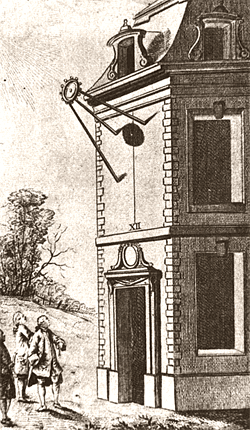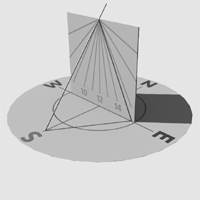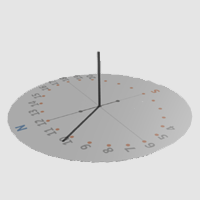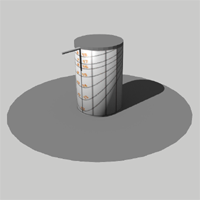SUNDIALS

When measuring time in common sense, we usually count small equal intervals of time: tic-tac.
The better equality of such intervals, the higher precision of the clock device.
In ancient times water, fire and sand clocks were used for timing equal intervals.
Pendulum clocks have started a new epoch of oscillatory timing in XIV-XVIII centuries.
Modern quartz devices are more perfect, while precision of
synchronized atomic clocks allows us to use global positioning systems all over the world.
Really fantastic accuracy being compared to ancient fire system, but...
... all these wonderful devices need some start value to become clocks.

And only sundials need nothing to be clock - they are heart of our timing system. They set initial values for all other clocks.
We can find an enlightening print in famous book about sundials - "La Gnomonique practique", Bedos de Celles, Paris, 1790. Surely, we don't perform such kind of Sun synchronization now, but all signals of time are generated according to mean sun time. Real sun movement and mean sun time are coordinated in observatory in Greenwich, and known term for such mean time is Greenwich Mean Time. But anyone in any place can observe such coordination with sundials. It makes sundials much more than clocks, what they really are, - first astronomical instrument. They better be called "timegiving" instrument on the contrary to timekeeping function of all other clocks. Thus, any discussions about sundial's precision have no sense in the terms of clocks.
Common for all sundials principle, is that they can measure Sun's height and/or azimuth with the help of pointer, named gnomon. Sundials can tell local true or mean sun time, but it is only one of gnomon's applications. Gnomonics is the Greek name for the science of computation, marking and making sundials. Before Greeks started to use sundials as clocks, gnomon was used by Sumers for astrological computations.
The accuracy of our contemporary clocks is far superior than our calendar's precision. That makes some preconditions for future problems. Greenwich Mean Time (GMT) is connected to real Sun (its real mean value), while practically the same Coordinated Universal Time (UTC) is not. UTC is kept within 1 second from GMT. Moreover, programmers know, that all our digital devices count seconds, past since the Unix Epoch - 1/01/1970, 00:00:00 GMT. It is the start moment for our virtual calendar, which we already are living in.
In gnomonics it is used to classify devices by gnomon orientation.
Vertical gnomon may be considered ideal for astronomical measurements of Sun's height and azimuth.
Much less such gnomon is used for usual timing. Vertical gnomon (orientation) is easily archived by a plumb on
the reeling deck. So, a marine sextant may be considered to be lineal descendant of vertical gnomon.
A bit different movable vertical gnomon is used in analemmatic sundials, which are so
popular now for safety and simplicity. Such sundials are discussed separately in the
THEORY section.
Horizontal gnomon, oriented to south and mounted on the vertical wall of the church or mosque is still the base time-giving instrument in all religions of the Exodus. Such placement is the best for mass observing, and was widely used for unequal hours timing till dark ages.
If we want to mark modern equal hours on sundials, the position of gnomon should be polar. Polar gnomon is oriented in parallel with Earth's rotation axis. In North hemisphere Pole is near Polar star (Ursa Minor's α). The Sun (all planets and stars) are rotating around polar gnomon with nearly constant speed of 15° per hour.
In many mordern English books about sundials word "gnomon" is used only for vertical pointer, while "style" is the name for Polar direction.
The dial's surface is the essential part of sundial - it is used for marking Sun's shadow from gnomon for different timing applications. In gnomonics we usually distinguish horizontal, vertical, and concave dials (last also known as scaphis). To tell the truth, any surface taking shadow of some steady object may be turned into sundials. It is the point where science of gnomonics transforms to art. Below you can see the basics of usage and marking most popular types of sundials. More sundials are described in section THEORY . And don't miss an article about wonderful sundials in section NEWS for inspiration.
TYPES OF SUNDIALS
Notice: Undefined index: sd in /home/akhost-1/analemma.ru/docs/articles/en-sundials.php on line 153






